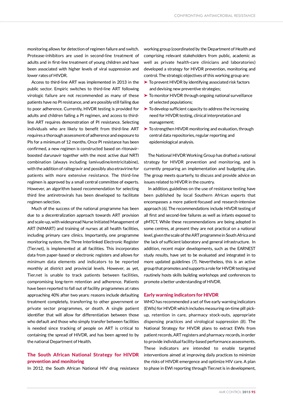
Monitoring, surveillance and control of HIVDR
In 2012, the South African National HIV drug resistance
working group (coordinated by the Department of Health
and comprising relevant stakeholders from National
Department of Health, public, academic and private health
clinicians and laboratories) established a strategy for HIV
drug resistance prevention, monitoring and control. The
strategy aims to address the multiple levels of intervention
required to establish activities needed to prevent, detect
and monitor the emergence of drug resistance, including:
‰ raising awareness of HIV drug resistance;
‰ documenting HIVDR patterns emerging in the country;
‰ strengthen preventive measures of HIVDR;
‰ preserving and monitoring the efficacy of current
regimens, and guiding the choice of future regimens;
‰ developing health-care worker capacity, ensuring
adherence to guidelines and policies, and training for
clinical management and interpretation;
‰ strengthening HIVDR monitoring and evaluation,
through data repositories, regular reporting and
epidemiological analysis.
South Africa has achieved significant progress towards
providing ART for HIV-positive people. At present, the NSP
targets for initiation an ART have been achieved, and current
figures indicate that 2.6 million eligible adults and children
are receiving ART (8). In addition, the fixed dose combination
(FDC) of WHO-recommended tenofovir, emtricitabine and
efavirenz is being rolled-out using a phased approach. Much
of this success has been due to a decentralization approach
towards ART provision and scale-up, with widespread Nurse
Initiated Management of ART (NIMART) training of nurses
at all health facilities, including primary care clinics.
Importantly, one programme monitoring system is used at all
facilities (tier.net), with most facilities reporting monthly.
However, as yet, tier.net does not track patients between
facilities, meaning that long-term characterization of
retention and adherence is problematic. The adoption of a
single patient identifier will allow for differentiation
between those who default and those who simply transfer
between facilities. Patients fall out of facility programmes at
rates that may approach 40% after two years: reasons
include defaulting on treatment completely, transferring to
other government or private sector programmes, or death.
Improved tracking of people on ART who are lost to followup
is critical.
Early warning indicators
The World Health Organization has recommended a set of
early warning indicators (EWIs) for HIVDR (9), measuring
rates on-time pill pick-up, retention in care, pharmacy stockouts,
appropriate dispensing practices and virological
suppression. The National Strategy for HIVDR focuses on
implementing EWI assessment at all sites, to be extracted
from patient records, ART registers and pharmacy records,
in order to provide facility-based performance assessments.
These reports and assessments are intended to allow for
targeted interventions to improve daily practices to
minimize the risks of HIVDR emergence and optimize HIV
care. A plan to phase in EWI reporting through tier.net is in
development, spanning three phases over a five-year period.
The pilot assessment will be carried out in two districts in
two provinces and will assess the quality of data in the health
facility, the availability of laboratory support to the facility,
the capacity in terms of human resources at the facility to
implement this analysis. The second and third phases will
expand this to at least half of, then all, facilities using tier.net
nationwide.
Surveillance
To support programmatic data, South Africa has adopted the
World Health Organization (WHO) recommended approach
for national HIVDR surveillance, including estimation of
rates of resistance in adult and paediatric patients initiating
(pre-treatment HIVDR) and receiving ART (acquired
HIVDR), patients infected with resistant HIV strains
(transmitted HIVDR) and infants infected with HIV despite
exposure to PMTCT (9). The WHO study protocols are
readily available, standardized, and can easily be adapted to
become country-specific. The HIVDR working group is
tasked with prioritizing, implementing and assessing the
outcomes from surveys.
Fortunately, there is a vibrant local interest in HIVDR.
Regional guidelines on the use of resistance testing have
been developed by local experts (10); adult and paediatric
state and private sector guidelines have clear sequencing
based on understandings of HIVDR development, and
conferences routinely host skills buildings, case studies and
talks on HIVDR.
Scaling up resistance testing for patient
management
Incorporating HIV drug resistance testing into routine
clinical management in ART-naïve patients and in patients
failing first-line ART is unrealistic in low-middle income
countries. Although NRTI resistance mutations are
commonly presented in patients failing first-line ART, a
number of observational studies have shown that that the
CONFRONTING ANTIMICROBIAL RESISTANCE
AMR CONTROL 2015 95